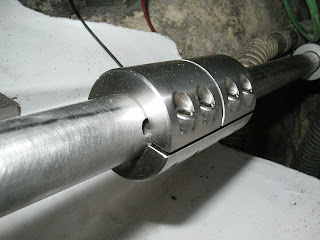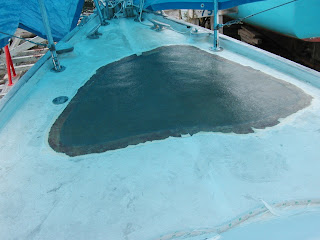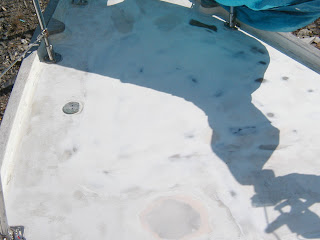
Our motor runs on 48 volts. We decided that two banks of batteries wired into 48 volt packs would allow us to find the best balance of space and weight. This meant that we had eight batteries to distribute in the way we thought would benefit us most. And that would be to keep them low and close to or in the middle of the boat.

We distributed them as follows:
- Two batteries in the compartment below the floor boards that is closest to the motor.
- Two batteries in the compartment forward of that (which leaves half of that compartment for other storage).
- Two in the bottom of the old icebox (Richard cut away part of the old icebox floor and part of the wall so that the batteries would sit close to the center of the boat and low down).
- One under the sink (Richard cut part of the liner so that it would be as low as possible, close to the center of the boat).
- One in the 'wet locker' by the galley.

This did mean giving up some storage space, and having to divide the large compartment below the floorboards into two. In the old icebox and the wet locker the batteries will be covered to create a shelf in one and a new bottom in the other.

For our charging system we chose to use four 24 volt Guest chargers. They charge each battery individually. They keep the batteries in balance by making sure that each one is charged as much as it needs, and using them avoids the distortions that can happen in charging each battery that happen when they are charged as a string.

We chose Guest because they are completely waterproof and available at a reasonable price. And in the electric boat forum Richard belongs to those that have them were pleased with and recommended them. The chargers can be hooked up to either shore power or to a generator.
The rest of our charging system uses solar panels, or the regeneration that is built in to the motor, and these are what we expect to rely on most of the time.
One of our friends, Uli Rentsch, is an electrical engineer. He helped us to develop our wiring diagram.
 For the wiring we used the type of wire used in battery cables (#2). Richard worked out the wiring size using a chart that shows the voltage loss for different sizes of wire. This size wire means that losses would be minimal with the current we're going to run.
For the wiring we used the type of wire used in battery cables (#2). Richard worked out the wiring size using a chart that shows the voltage loss for different sizes of wire. This size wire means that losses would be minimal with the current we're going to run.We used lugs to connect the wires to the battery terminals, and protected all the connections with marine grade heat shrink which has a sealant in it that is activated by heat.
One very important thing we learned: as we wired the two 48 volt packs we needed to make sure that the lengths of the wires between corresponding pairs of batteries in each bank were the same. That is, the length of the wire between batteries 1 and 2 in the first bank had to be the same as the length of the wire between batteries 1 and 2 in the second bank, and so on. Each bank has its own switch, so that we can operate either on one or the other, or on both when both switches are turned on.
Setting the switches up this way means that if necessary (if, say, there is a problem with one battery in one bank) we can isolate the banks from each other and still have 48 volts of power to run on.
Using both banks at the same time has the advantage of reducing the Peukert effect. This can be described this way: The more current you draw from a battery the less capacity it has, so that it provides power for a shorter time than it would if you drew less current from it. You could think of it this way: the greater draw actually reduces the real capacity of the battery - a 10 amp draw from a 100 amp battery allows the battery to operate as if it had 100 amps, but a 50 amp draw on the same battery would make it operate as an 80 amp battery.

Although the wiring diagram does not show it, there is main fuse that acts for both banks when both are switched on and providing power as one.

Rather than have a separate battery, we decided to run house loads through a converter which steps the 48 volt current down to 12 volts. Partly this means not having to carry and find space for one more battery - but it also means that our batteries will be used rather than sit idle, and this is better for them.
The actual weight of the electric motor plus batteries, wiring and chargers, etc, is about the same as the weight of an Atomic 4 engine and a full tank of gas.





























